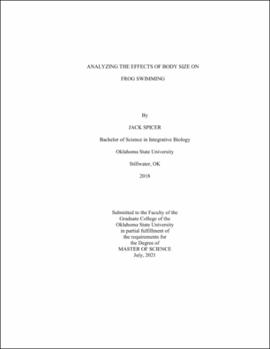| dc.description.abstract | The scaling of traits with body size, along with the effects it has on performance and evolution, has long been studied in evolutionary biology and biomechanics. These effects can be observed in locomotion across many different organisms. Understanding exactly how characteristics of locomotor performance scale with body size, as well as how body size might constrain performance, are keys for understanding how body size affects performance and evolution. In this study I quantified swimming performance across a range of body sizes (snout vent length, SVL) in the semi-aquatic frog species Rana catesbeiana. First, I defined swimming performance as peak swimming speed, due to its importance in the survival of Rana catesbeiana. Next, I identified and quantified factors that should affect velocity as well as scale with body size (drag, peak momentum, and wake circulation). Using high-speed recordings of swimming trials paired with digital particle image velocimetry (PIV), I extracted both the swimming speed and the resulting flow velocity. Velocity vector fields from PIV analysis allowed me to quantify momentum and circulation of the flow. Drag force data were acquired by towing specimens on a linear actuator fitted with a strain gauge. To summarize the effect of body size on swimming speed and these performance variables, I fit ordinary least squares regressions between SVL and the variables of swimming speed, momentum, and circulation. My analysis showed that SVL had no significant effect on swimming speed, momentum, or circulation. Drag force profiles showed that larger animals do experience higher resistive drag force at higher speeds, consistent with expectations. The lack of effect of body size on performance variables could have resulted from study limitations, such as small sample size and sub-optimal performance data. Further research with more individuals and modified methods may be needed to confirm the findings of this study. | |
